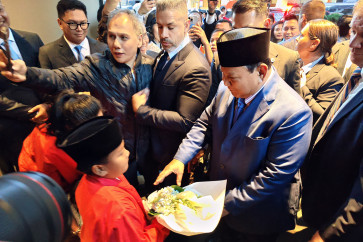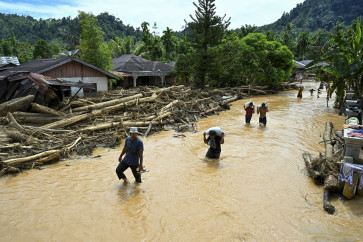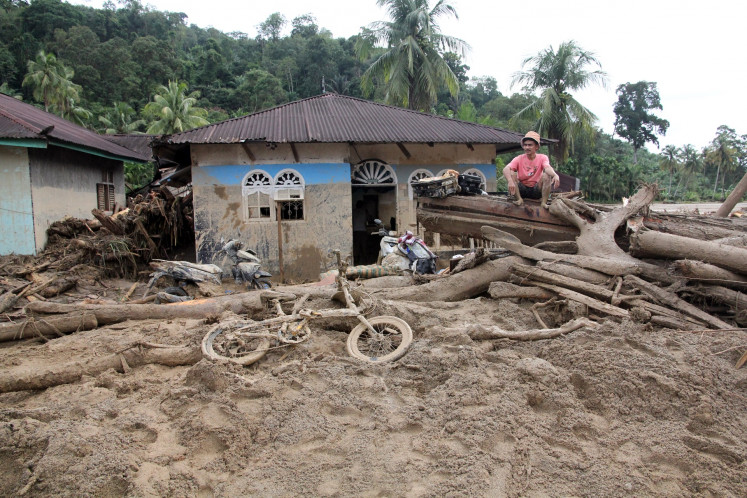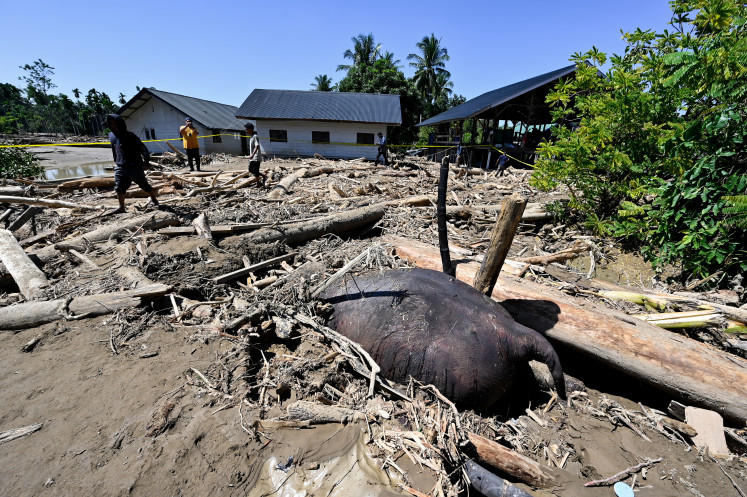Popular Reads
Top Results
Can't find what you're looking for?
View all search resultsPopular Reads
Top Results
Can't find what you're looking for?
View all search resultsGranting Indonesian youth access to reproductive health rights
Courtesy of the National Population and Family Planning BoardBoth in urban and rural settings, most young people in Indonesia still find it difficult to get accurate information on sexual reproductive health
Change text size
Gift Premium Articles
to Anyone
Courtesy of the National Population and Family Planning Board
Both in urban and rural settings, most young people in Indonesia still find it difficult to get accurate information on sexual reproductive health.
Nindya (not her real name) got pregnant when she was 15 years old and was still in her first year at a high school in Bandung, West Java.
“My boyfriend told me to drink grated young pineapple mixed with soda drinks and arak [homemade distilled alcohol] in order to terminate my pregnancy,” she recalled, adding that she also drank large amounts of herbal medicines to abort the fetus.
Despite her efforts, her pregnancy became more and more visible, forcing her to finally tell her parents about her condition.
“I felt so shocked, ashamed and humiliated to hear my daughter’s confession. But, then I realized that my husband and I, as parents, should bear a huge responsibility for her ‘mistake,’” admitted Nindya’s mother, a lecturer.
With the support of her parents, Nindya gave birth to a healthy baby boy, who is now 7 years old, and she is currently studying at a university in her hometown.
“I had been grappling with feelings of guilt, shame, isolation and desperation for years. If I had been able to get information and access to information on reproductive health and youth-friendly health services earlier, my life would have been different,” said Nindya, who is now an active youth advocate and a peer educator.
Unfortunately, not all young girls who find themselves in the same situation are lucky enough to have loving and empowering parents.
Anna, 17, from Papua, admitted she had frequent sex with her boyfriend.
“My friends told me that I would not get pregnant if we had sex standing up,” she said.
Anna got pregnant anyway, and her boyfriend forced her to drink tonics made of bitterroot, which can easily be found in Papua’s forests and is locally believed to induce abortions. She even resorted to swallowing hair dyes, which led to severe bleeding.
Behind all these stories is the reality that in both urban and rural settings, most young Indonesians find it difficult to receive accurate information on sexual reproductive health (SRH) or have access to health clinics that cater to their needs.
Most young people quench their curiosity about sex through pornography found on the internet, porn magazines and tall tales told by friends.
The United Nations Population Fund (UNFPA) defines SRH as a “state of physical, emotional, mental and social wellbeing related to sexuality and to the reproductive health.”
Health talk: The first National Adolescent Summit gives a platform for young people to have an important and irreplaceable role in promoting sexual and reproductive health (SRH). (JP/Bambang Muryanto)
This ranges from learning about puberty and menstruation, and preventing sexually transmitted infections (STI), to understanding the risks of early pregnancy.
“It happens in many countries that issues related to sexual and reproductive health and rights [SRHR], particularly on contraception for unmarried young people, and incorporation of comprehensive SRH education in the curriculum are sensitive, given social, cultural and religious norms,” said Annette Robertson Sachs, a representative of UNFPA Indonesia.
“While there was a readiness to listen to youths’ voices, government officials felt that they could not accommodate the needs of all young people.”
Therefore, it is important that government works together with the private sector, including NGOs and youth networks, to fulfill the needs of all young people, particularly on sensitive issues such as sexual and reproductive health, she said.
However, Robert Blum, a professor at the department of Population and Reproductive Health at the Johns Hopkins Bloomberg School of Public Health, said that in Indonesia and many neighboring Asian countries, SRH remains a taboo topic that is never discussed at home or taught in schools.
“[The] youth are often missing out in important information that, in many cases, can save their lives,” said Blum, who conducts research and studies on youths around the world.
Very few outlets of information and service provisions exist for Indonesian youths.
“Moreover, SRH messages often focus on physical things, such as prevention of sexual transmission infection or family planning — topics that may not resonate with youth. Instead, educators or advocates should link SRH with topics related to boosting youth’s self-worth, self esteem and feeling good about their bodies, their futures and developing healthy relationships with female and male friends.”
Failing to meet the needs of Indonesia’s younger generation in providing SRH information may lead to increasing numbers of unwanted pregnancies, teen marriages and sexual violence.
A qualitative joint study by the University of Gajah Mada medical school’s Center for Reproductive Health and the Johns Hopkins Bloomberg School of Public Health Center for Communication Program (JHUCCP) conducted in 18 cities and regencies across nine provinces in early 2017, reveals that adolescents — youths aged 10-19 years old — are increasingly permissive toward sexual behavior.
The study says around 6 percent of adolescents have had sexual intercourse, and about 0.1 to 0.4 percent of boys and girls had sexual intercourse for the first time at the age of 15-17 years old.
The study also shows that approximately 2.4 percent of adolescents are married, and around 9.5 percent of girls aged 15-19 years old have already given birth or were currently pregnant.
It is estimated that 500,000 adolescent girls give birth every year in Indonesia.
“The study reveals a harsh reality […] in Indonesia and therefore, it is very crucial to address adolescent issues, and their sexual reproductive health and rights — which will lead to long-terms benefits for Indonesia,” said JHUCCP Indonesia representative Fitri Putjuk.
Indonesia’s adolescent population stands at about 45.8 million, or 13.3 percent of its 259 million population.
“By 2030, these adolescents will reach the peak productive years of their 30s. Unless we provide them with the necessary skills and knowledge [about] SHR, Indonesia will lose the opportunity to gain from its demographic dividend,” Fitri said.

![Courtesy of the National Population and Family Planning Board" width="780" border="0" height="233"><span class="caption">Courtesy of the National Population and Family Planning Board</span></span></p><p><em>Both in urban and rural settings, most young people in Indonesia still find it difficult to get accurate<span> information on sexual reproductive health</span><span>.</span></em></p><p><span>N</span><span>indya (not her real name) got pregnant when she was 15 years old and was still in her first year at a high school in Bandung, West Java. </span></p><p><span>“My boyfriend told me to drink grated young pineapple mixed with soda drinks and </span><span>arak</span><span> [homemade distilled alcohol] in order to terminate my pregnancy,” she recalled, adding that she also drank large amounts of herbal medicines to abort the fetus.</span></p><p>Despite her efforts, her pregnancy became more and more visible, forcing her to finally tell her parents about her condition.</p><p>“I felt so shocked, ashamed and humiliated to hear my daughter’s confession. But, then I realized that my husband and I, as parents, should bear a huge responsibility for her ‘mistake,’” admitted Nindya’s mother, a lecturer.</p><p>With the support of her parents, Nindya gave birth to a healthy baby boy, who is now 7 years old, and she is currently studying at a university in her hometown.</p><p>“I had been grappling with feelings of guilt, shame, isolation and desperation for years. If I had been able to get information and access to information on reproductive health and youth-friendly health services earlier, my life would have been different,” said Nindya, who is now an active youth advocate and a peer educator.</p><p>Unfortunately, not all young girls who find themselves in the same situation are lucky enough to have loving and empowering parents. </p><p>Anna, 17, from Papua, admitted she had frequent sex with her boyfriend. </p><p>“My friends told me that I would not get pregnant if we had sex standing up,” she said.</p><p>Anna got pregnant anyway, and her boyfriend forced her to drink tonics made of bitterroot, which can easily be found in Papua’s forests and is locally believed to induce abortions. She even resorted to swallowing hair dyes, which led to severe bleeding.</p><p>Behind all these stories is the reality that in both urban and rural settings, most young Indonesians find it difficult to receive accurate information on sexual reproductive health (SRH) or have access to health clinics that cater to their needs. </p><p>Most young people quench their curiosity about sex through pornography found on the internet, porn magazines and tall tales told by friends.</p><p>The United Nations Population Fund (UNFPA) defines SRH as a “state of physical, emotional, mental and social wellbeing related to sexuality and to the reproductive health.” </p><p><span class="inline inline-center"><img class="image image-img_assist_custom-780x536 " src="http://202.158.21.182/files/images2/23-healthtalk.img_assist_custom-780x536.jpg" alt="Health talk: The first National Adolescent Summit gives a platform for young people to have an important and irreplaceable role in promoting sexual and reproductive health (SRH). (JP/Bambang Muryanto)" title="Health talk: The first National Adolescent Summit gives a platform for young people to have an important and irreplaceable role in promoting sexual and reproductive health (SRH). (JP/Bambang Muryanto)](https://www.thejakartapost.com/files/images2/23-sidebar.img_assist_custom-780x234.jpg)









